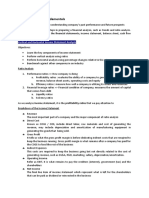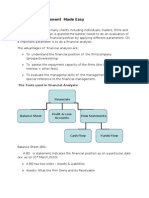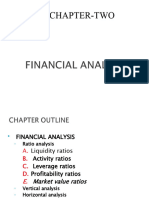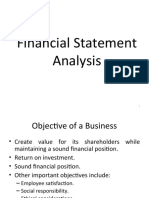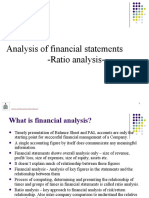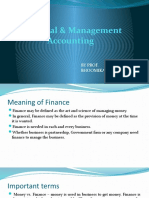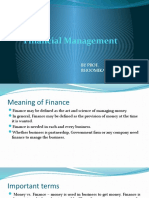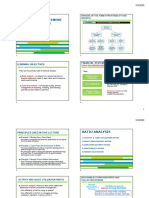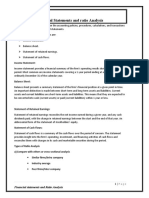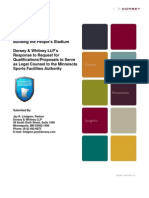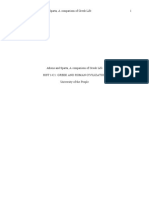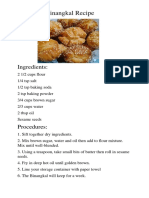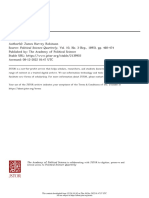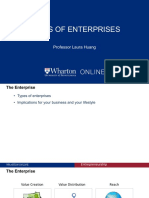FINANCIAL MANAGEMENT
(MBA 622)
CHAPTER TWO
FINANCIAL PERFORMANCE ANALYSIS
www.company.com
� 2.1 Rationale for Evaluating Firm’s
Financial Performance
• To assess a firm’s past, present, & future
financial health
• To base for intelligent decision making &
starting point for planning the future
courses of actions
• Objectives:
• To determine financial strength
• To identify weaknesses
• To identify significance r/ships existing
among the key figures
www.company.com
� 2.2 Users of Financial Analysis
• Investors: Existing & Potential
• Lenders: Current & Potential
• Managers
• Suppliers
• Employees
• Others:
─ Government Bodies
─ Competitors
─ Rating & Indexing Agencies
─ Investors’ Services
─ Financial Markets
www.company.com
� 2.3 Standards for Evaluating
• Benchmarks / Basis for Comparison
• Various Analysis Approaches:
• 2.3.1 Time-Series Analysis:
• Applied when evaluating performance
overtime
• Present/recent ratios compared with a
firm’s own past ratios
• Allows a firm to determining whether its
progressing as planned
www.company.com
� …. Cont’d
• 2.3.2 Cross-Sectional Analysis:
• Comparison of different firms’ financial
ratios at the same point in time
• How well a firm performed / positioned
in relation to its competitors
• To uncover major operating deficiencies
www.company.com
� …. Cont’d
• 2.3.3 Industry Analysis:
• Comparison of a particular ratio to the
standard made to isolate any deviation
from the norm
• Too high or too low values reflect
symptoms of a problem
• Provides a useful insight on how the
firm measures up to its competitors
• 2.3.4 Pro Forma Analysis:
• Comparing a ratio to its corresponding
from the pro forma statements
www.company.com
� 2.4 Types of Ratios
• 2.4.1 Liquidity Ratios:
Ability to meet current obligations
• 2.4.2 Leverage Ratios:
shows the degree of a firm’s indebtedness
• 2.4.3 Activity Ratios:
Proper & effective use of assets
• 2.4.4 Profitability Ratios:
Measures management effectiveness
• 2.4.5 Market Value Ratios:
Indicators of what investors think of firm’s past
results & future prospects
www.company.com
� 2.4.1 Liquidity Ratios
• CURRENT RATIO
measures a firm’s ability to satisfy or cover claims of
short-term creditors by using only current assets
Current Assets
Current
= Current Liabilities
Ratio
• QUICK (ACID-TEST) RATIO
measures short-term liquidity by removing the least
liquid assets
Current Assets - Inventories
Quick
= Current Liabilities
Ratio
www.company.com
� 2.4.2 Leverage Ratios
• DEBT RATIO
shows the extent of assets financed through debts
Total Liabilities
Debt
= Total Assets
Ratio
• DEBT-TO-EQUITY RATIO
expresses the relationship between the amount of
a firm’s total assets financed by creditors (debt) &
owners (equity)
Total Liabilities
Debt-Equity
= Stockholders’ Equity
Ratio
www.company.com
� 2.4.2 Leverage Ratios ….cont’d
• TIMES INTEREST EARNED RATIO
measures a firm’s ability to pay interest on a timely
basis
EBIT
Times Interest
= Interest
Earned Ratio
• CASH COVERAGE RATIO
indicates the extent to which earnings may fall
without causing any problem to the firm regarding the
payment of interest charges
EBIT + Depreciation
Cash Coverage
= Interest
Ratio
www.company.com
� 2.4.3 Activity Ratios
• INVENTORY TURNOVER
measures the efficiency with which a firm is managing
its investments in inventories
CGS
Inventory Turnover =
Average Inventory
• AVERAGE AGE OF INVENTORY
the number of days inventory is kept before it is
sold
No of Days in a Year (365 Days)
Average Age of
= Inventory Turnover
Inventory
www.company.com
� 2.4.3 Activity Ratios ….cont’d
• RECEIVABLES TURNOVER
measures the liquidity of a firm’s accounts receivable
Net Sales
Receivables
= Average Accounts Receivables
Turnover
• AVERAGE COLLECTION PERIOD
shows how long it takes for accounts receivables to
be cleared (collected)
365 Days
Average Collection Period =
Receivables Turnover
www.company.com
� 2.4.3 Activity Ratios ….cont’d
• FIXED ASSETS TURNOVER
measures the efficiency with which the firm has been
using its fixed assets to generate revenue
Net Sales
Fixed Assets Turnover =
Average Fixed Assets
• TOTAL ASSETS TURNOVER
measures a firm’s efficiency in managing its total
assets to generate sales
Net Sales
Fixed Assets
= Total Assets
Turnover
www.company.com
� 2.4.4 Profitability Ratios
• GROSS PROFIT MARGIN
indicates management’s effectiveness in pricing policy,
generating sales and controlling production costs
Gross Profit
Gross Profit Margin =
Net Sales
• NET PROFIT MARGIN
measures the profitableness of sales
Net Income
Net Profit Margin =
Net Sales
www.company.com
� 2.4.4 Profitability Ratios ….cont’d
• RETURN ON INVESTMENT (ROI)
measures the overall effectiveness of management in
generate profit with its available assets
Net Income
Return on Investment (ROI) =
Total Assets
• RETURN ON EQUITY (ROE)
measures the earning power on shareholders’ book
value investment
Net Income
Return on Equity (ROE) =
SHE
www.company.com
� 2.4.4 Profitability Ratios ….cont’d
• EARNING PER SHARE
measures profitability of the firm from the view point of
ordinary shareholders
indicates the profit available to each ordinary share
Earnings Avail. to Common
Earning Per Share Stockholders
=
(EPS) Number of Shares of
Common Stock Outstanding
www.company.com
� 2.4.5 Market Value Ratios
• PRICE EARNINGS (P/E) RATIO
indicator of the firm’s growth prospects, risk
characteristics, shareholders orientation, corporate
reputation, and the firm’s level of liquidity
Market Price per Share
P/E Ratio =
Earning per Share
• MARKET-TO-BOOK RATIO
measures a firm’s contributions to wealth creation
in the society
MV per Share
Market-to-Book Ratio =
BV per Share
www.company.com
� 2.5 Benefits of Ratio Analysis
• Simplifies the financial statements
• Provides useful information concerning a firm’s
operation and financial conditions
• Helps identify symptoms of problems
• Helps reach to the causes of problems
• Provides a common ground for comparisons
• Helps in comparing companies of different size
with each other
• Helps in trend analysis which involves comparing
a single company over a period
• Highlights important information in simple form
quickly
www.company.com
� 2.6 Limitations in Ratio Analysis
• Difficulty to develop a meaningful set of
industry averages
• Tendency of firms just to be better than the
average
• Inflation may distort a firm’s balance sheet
• Employing “window dressing” techniques
• Differences in accounting practices
• Difficulty of generalizing “good” or “bad” on a
ratio
• Difficulty of overall evaluation
www.company.com
� 2.7 Du Pont Analysis
• Developed by Donaldson Brown in 1914
• Du Pont Corp. started to use in the 1920s
• Expressing the ROE breaking into 3 parts
• Meant to provide an adequate measure of overall
effectiveness
Sales Assets Equity
ROE =
Profitability × Efficiency × Multiplier
Total
Net Profit Equity
=
Margin
× Assets × Multiplier
Turnover
Net Income Net Sales Total Assets
= × Total ×
Net Sales SHE
Assets
Net Income Net Sales Debt
= × Total × 1+
Net Sales
www.company.com Equity
Assets
� End of Chapter Two!
THANK YOU
For
Your
ATTENTION!
www.company.com



